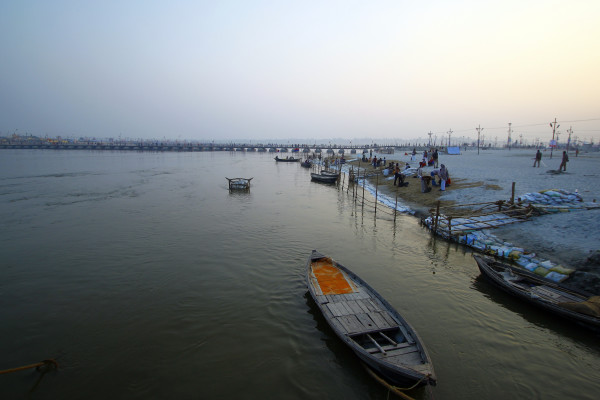The film series based on J. K. Rowling’s award-winning novels that have appealed to both adults and children; consist of eight fantasy films, starting with Harry Potter and the Philosopher’s Stone (2001) and ending with the finale in 2011, putting this successful franchise on the map with others like Star Wars, Pirates of the Caribbean, Indiana Jones and James Bond.
In the finale film, Harry Potter (Daniel Radcliffe), Ron Weasley (Rupert Grint), and Hermione Granger (Emma Watson), who after destroying one Horcrux (the magical object that makes the Dark Lord immortal) and discovering the significance of the three Deathly Hallows, continue on their quest of finding and destroying the remaining three Horcruxes, in an attempt to destroy Lord Voldemort. But as the mystical Deathly Hallows are uncovered, and Voldemort finds out about their mission, he aims to complete his final stage to ultimate power and launches an attack on Hogwarts School. The three return here for one last stand, and so a crucial battle and showdown begins between the forces of good and the dark forces of evil that threaten to take over the Wizarding and Muggle worlds.
Regarding the series as a whole, while some fans of the books prefer the approach of the first two films that were more faithful, there are others who prefer the later stylised films that are more character-driven. Hats off to Warner Brothers for managing this franchise with such poise, positioning each film as a worldwide event, having its unique identity while building on the last one and creating anticipation for the next. However, despite the author, J. K. Rowling, being the constant supportive link between all the films, the varying influences of the different directors have lead to a disjointed series, as naturally, each director would have his own vision and interpretation.
Harry Potter, his classmates, teachers and enemies pass through the hands of four directors, each bringing to the table a distinctive style and sensibility. Chris Columbus dealt with Harry’s early years. Alfonso Cuaron and Mike Newell handled the middle films, as the tone began to get more dramatic and complex, and David Yates, was responsible for the final four, handling the dark material, and the more lighthearted moments with a flare for incredible special effects and CGI, as is particularly evident in the final film.
As the series progresses, the material lends itself to diverse genres ranging from a children’s movie to an ominous political thriller, shifting the tone and colour palette from the bright, flat lighting to a horror-movie like sombre and dangerous feel.
The young actors mature along with their characters, as their talents blossom and roles become increasingly complex. Hermione, the role model for girls in this boy-dominated franchise, transforms from a nerdy know-it-all to a sophisticated and poised young woman. Ron, Harry’s faithful wing-man doesn’t change as much as the others, but Grint’s range evolves greatly. And then there is Harry, who confronted by physical and moral challenges, has to confront difficult emotions as his tasks become more perilous. The trio grows up together, and find their way through the difficult and confusing period of adolescence. Their relationships, though not always harmonious, are strong enough to ensure that they are always by each other’s side.
The rapid technological advancements through the series developed possibilities for broomstick-assisted flight and computer-generated monsters, to special effects ranging from the candles that float above the Hogwarts dining room to the foreboding winged horses called Thestrals that soar through Order of the Phoenix. Although the use of 3D for the finale is exciting, the film is a bit too dark in colour to really benefit from the format, so if one was to choose to see it in 2D, it wouldn’t really make much difference.
The author, J. K. Rowling’s rags-to-riches real-life plot is as unreal as the world she creates of dragons and goblins. Her saga began with a failed marriage, as a single mother in Edinburgh, just about surviving on welfare, when she finished her first novel Harry Potter and the Philosopher’s Stone. David Heyman (producer) thought the title was “rubbish” and a copy of it ended up on a low-priority shelf in his London office, until a secretary took it home for the weekend to curiously glance through it. Her enthusiasm infected Heyman, the story captured his imagination, and the rest was history, transporting Rowling from ‘struggling mum’ to ‘multi-millionaire’.
This story of a boy with a wand has fascinated book lovers and movie buffs for over a decade. But the big question is: will Harry Potter stand the test of time? Although, the true impact of the books and films may not be fully recognized for a decade or two, one can only guess that considering The Chronicles of Narnia are still popular 60 years after their publication, and Potter has already been around for a decade and is still going strong, it possibly could. But on the other hand, pop culture might just move on, as the movies are complete and there’s nothing else to look forward to. On a lighter note, if we were to look way into the future, kids might not even know what a book is! But the story and characters from the films might last as Heyman points out “The fantastical elements and the action are wonderful, but the characters are what people remember.”
Today, saying goodbye to Harry Potter on film would be bittersweet for all fans, as while they would miss seeing the characters, watching them go out on such a high note would be satisfying. If Rowling does decide to pick up her pen again to create more magic, let’s hope the film version’s team would be the same as the ones who made these 8 magical films work.


